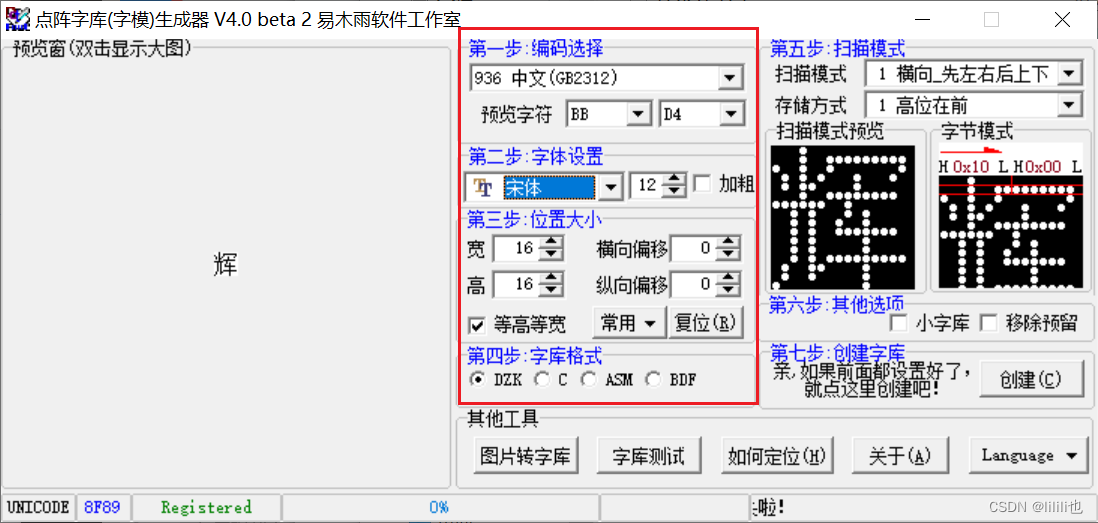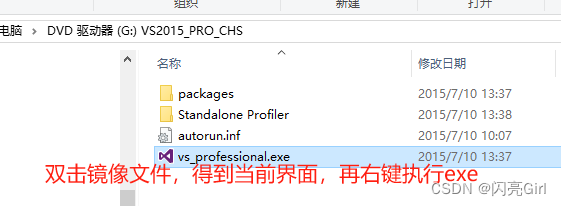文章目录
- 1.概述
- 2.实现
- 定义节点
- 查询
- Comparable
- 最小
- 最大
- 新增
- 前驱后继
- 删除
- 找小的
- 找大的
- 找之间
- 小结
- 3.习题
- E01. 删除节点-Leetcode 450
- E02. 新增节点-Leetcode 701
- E03. 查询节点-Leetcode 700
- E04. 验证二叉搜索树-Leetcode 98
- E05. 求范围和-Leetcode 938
- E06. 根据前序遍历结果构造二叉搜索树-Leetcode 1008
- E07. 二叉搜索树的最近公共祖先-Leetcode 235
1.概述
二叉搜索树(也称二叉排序树)是符合下面特征的二叉树:
- 树节点增加 key 属性,用来比较谁大谁小,key 不可以重复
- 对于任意一个树节点,它的 key 比左子树的 key 都大,同时也比右子树的 key 都小,例如下图所示

查找 7 (从根开始)应用二分查找算法,只需三次比较
- 与 4 比,较之大,向右找
- 与 6 比,较之大,继续向右找
- 与 7 比,找到
查找、插入、删除的时间复杂度与树高相关
- 如果这棵树左右平衡,时间复杂度均是 O ( log N ) O(\log{N}) O(logN)
- 如果这棵树左右高度相差过大,这时是最糟的情况,时间复杂度是
O
(
N
)
O(N)
O(N)

- 二叉搜索树 - binary search tree,简称 BST
- 二叉排序树 - binary ordered tree 或 binary sorted tree
2.实现
定义节点
static class BSTNode {
int key; // 若希望任意类型作为 key, 则可以将其设计为 Comparable 接口
Object value;
BSTNode left;
BSTNode right;
public BSTNode(int key) {
this.key = key;
this.value = key;
}
public BSTNode(int key, Object value) {
this.key = key;
this.value = value;
}
public BSTNode(int key, Object value, BSTNode left, BSTNode right) {
this.key = key;
this.value = value;
this.left = left;
this.right = right;
}
}
查询
递归实现
public Object get(int key) {
return doGet(root, key);
}
private Object doGet(BSTNode node, int key) {
if (node == null) {
return null; // 没找到
}
if (key < node.key) {
return doGet(node.left, key); // 向左找
} else if (node.key < key) {
return doGet(node.right, key); // 向右找
} else {
return node.value; // 找到了
}
}
非递归实现
public Object get(int key) {
BSTNode node = root;
while (node != null) {
if (key < node.key) {
node = node.left;
} else if (node.key < key) {
node = node.right;
} else {
return node.value;
}
}
return null;
}
Comparable
让除 int 外更多的类型能够作为 key,一种方式是 key 必须实现 Comparable 接口
public class BSTTree2<T extends Comparable<T>> {
static class BSTNode<T> {
T key; // 若希望任意类型作为 key, 则可以将其设计为 Comparable 接口
Object value;
BSTNode<T> left;
BSTNode<T> right;
public BSTNode(T key) {
this.key = key;
this.value = key;
}
public BSTNode(T key, Object value) {
this.key = key;
this.value = value;
}
public BSTNode(T key, Object value, BSTNode<T> left, BSTNode<T> right) {
this.key = key;
this.value = value;
this.left = left;
this.right = right;
}
}
BSTNode<T> root;
public Object get(T key) {
return doGet(root, key);
}
private Object doGet(BSTNode<T> node, T key) {
if (node == null) {
return null;
}
int result = node.key.compareTo(key);
if (result > 0) {
return doGet(node.left, key);
} else if (result < 0) {
return doGet(node.right, key);
} else {
return node.value;
}
}
}
最小
递归实现
public Object min() {
return doMin(root);
}
public Object doMin(BSTNode node) {
if (node == null) {
return null;
}
// 左边已走到头
if (node.left == null) {
return node.value;
}
return doMin(node.left);
}
非递归实现
public Object min() {
if (root == null) {
return null;
}
BSTNode p = root;
// 左边未走到头
while (p.left != null) {
p = p.left;
}
return p.value;
}
最大
递归实现
public Object max() {
return doMax(root);
}
public Object doMax(BSTNode node) {
if (node == null) {
return null;
}
// 右边已走到头
if (node.left == null) {
return node.value;
}
return doMin(node.right);
}
非递归实现
public Object max() {
if (root == null) {
return null;
}
BSTNode p = root;
// 右边未走到头
while (p.right != null) {
p = p.right;
}
return p.value;
}
新增
递归实现
public void put(int key, Object value) {
root = doPut(root, key, value);
}
private BSTNode doPut(BSTNode node, int key, Object value) {
if (node == null) {
return new BSTNode(key, value);
}
if (key < node.key) {
node.left = doPut(node.left, key, value);
} else if (node.key < key) {
node.right = doPut(node.right, key, value);
} else {
node.value = value;
}
return node;
}
- 若找到 key,走 else 更新找到节点的值
- 若没找到 key,走第一个 if,创建并返回新节点
- 返回的新节点,作为上次递归时 node 的左孩子或右孩子
- 缺点会有很多不必要的赋值操作
非递归实现
public void put(int key, Object value) {
BSTNode node = root;
BSTNode parent = null;
while (node != null) {
parent = node;
if (key < node.key) {
node = node.left;
} else if (node.key < key) {
node = node.right;
} else {
// 1. key 存在则更新
node.value = value;
return;
}
}
// 2. key 不存在则新增
if (parent == null) {
root = new BSTNode(key, value);
} else if (key < parent.key) {
parent.left = new BSTNode(key, value);
} else {
parent.right = new BSTNode(key, value);
}
}
前驱后继
一个节点的前驱(前任)节点是指比它小的节点中,最大的那个
一个节点的后继(后任)节点是指比它大的节点中,最小的那个
中序遍历,获得排序结果,很容易找到前驱后继
找前驱

- 节点有左子树,前驱节点就是左子树的最大值
- 2 的前驱是1
- 4 的前驱是 3
- 6 的前驱是 5
- 7 的前驱是 6
- 节点没有左子树,若离它最近的祖先自从左而来,此祖先即为前驱
- 3 的祖先 2 自左而来,前驱 2
- 5 的祖先 4 自左而来,前驱 4
- 8 的祖先 7 自左而来,前驱 7
- 1 没有这样的祖先,前驱 null
找后继

- 节点有右子树,后继节点即为右子树的最小值
- 2 的后继 3
- 3 的后继 4
- 5 的后继 6
- 7 的后继 8
- 节点没有右子树,若离它最近的祖先自从右而来,此祖先即为后继
- 1 的祖先 2 自右而来,后继 2
- 4 的祖先 5 自右而来,后继 5
- 6 的祖先 7 自右而来,后继 7
- 8 没有这样的祖先,后继 null
public Object predecessor(int key) {
BSTNode ancestorFromLeft = null;
BSTNode p = root;
while (p != null) {
if (key < p.key) {
p = p.left;
} else if (p.key < key) {
ancestorFromLeft = p;
p = p.right;
} else {
break;
}
}
if (p == null) {
return null;
}
// 情况1 - 有左孩子
if (p.left != null) {
return max(p.left);
}
// 情况2 - 有祖先自左而来
return ancestorFromLeft != null ? ancestorFromLeft.value : null;
}
public Object successor(int key) {
BSTNode ancestorFromRight = null;
BSTNode p = root;
while (p != null) {
if (key < p.key) {
ancestorFromRight = p;
p = p.left;
} else if (p.key < key) {
p = p.right;
} else {
break;
}
}
if (p == null) {
return null;
}
// 情况1 - 有右孩子
if (p.right != null) {
return min(p.right);
}
// 情况2 - 有祖先自右而来
return ancestorFromRight != null ? ancestorFromRight.value : null;
}
删除
删除某节点(称为 D),必须先找到被删除节点的父节点,这里称为 Parent
- 删除节点没有左孩子,将右孩子托孤给 Parent
- 删除节点没有右孩子,将左孩子托孤给 Parent
- 删除节点左右孩子都没有,已经被涵盖在情况1、情况2 当中,把 null 托孤给 Parent
- 删除节点左右孩子都有,可以将它的后继节点(称为 S)托孤给 Parent,设 S 的父亲为 SP,又分两种情况
- SP 就是被删除节点,此时 D 与 S 紧邻,只需将 S 托孤给 Parent
- SP 不是被删除节点,此时 D 与 S 不相邻,此时需要将 S 的后代托孤给 SP,再将 S 托孤给 Parent
非递归实现
/**
* <h3>根据关键字删除</h3>
*
* @param key 关键字
* @return 被删除关键字对应值
*/
public Object delete(int key) {
BSTNode p = root;
BSTNode parent = null;
while (p != null) {
if (key < p.key) {
parent = p;
p = p.left;
} else if (p.key < key) {
parent = p;
p = p.right;
} else {
break;
}
}
if (p == null) {
return null;
}
// 删除操作
if (p.left == null) {
shift(parent, p, p.right); // 情况1
} else if (p.right == null) {
shift(parent, p, p.left); // 情况2
} else {
// 情况4
// 4.1 被删除节点找后继
BSTNode s = p.right;
BSTNode sParent = p; // 后继父亲
while (s.left != null) {
sParent = s;
s = s.left;
}
// 4.2 删除和后继不相邻, 处理后继的后事
if (sParent != p) {
shift(sParent, s, s.right); // 不可能有左孩子
s.right = p.right;
}
// 4.3 后继取代被删除节点
shift(parent, p, s);
s.left = p.left;
}
return p.value;
}
/**
* 托孤方法
*
* @param parent 被删除节点的父亲
* @param deleted 被删除节点
* @param child 被顶上去的节点
*/
// 只考虑让 n1父亲的左或右孩子指向 n2, n1自己的左或右孩子并未在方法内改变
private void shift(BSTNode parent, BSTNode deleted, BSTNode child) {
if (parent == null) {
root = child;
} else if (deleted == parent.left) {
parent.left = child;
} else {
parent.right = child;
}
}
递归实现
public Object delete(int key) {
ArrayList<Object> result = new ArrayList<>();
root = doDelete(root, key, result);
return result.isEmpty() ? null : result.get(0);
}
public BSTNode doDelete(BSTNode node, int key, ArrayList<Object> result) {
if (node == null) {
return null;
}
if (key < node.key) {
node.left = doDelete(node.left, key, result);
return node;
}
if (node.key < key) {
node.right = doDelete(node.right, key, result);
return node;
}
result.add(node.value);
if (node.left != null && node.right != null) {
BSTNode s = node.right;
while (s.left != null) {
s = s.left;
}
s.right = doDelete(node.right, s.key, new ArrayList<>());
s.left = node.left;
return s;
}
return node.left != null ? node.left : node.right;
}
说明
ArrayList<Object> result用来保存被删除节点的值- 第二、第三个 if 对应没找到的情况,继续递归查找和删除, doDelete 返回值代表删剩下的,需要更新
- 最后一个 return 对应删除节点只有一个孩子的情况,返回那个不为空的孩子,待删节点自己因没有返回而被删除
- 第四个 if 对应删除节点有两个孩子的情况,此时需要找到后继节点,并在待删除节点的右子树中删掉后继节点,最后用后继节点替代掉待删除节点返回,改变后继节点的左右指针
找小的
public List<Object> less(int key) {
ArrayList<Object> result = new ArrayList<>();
BSTNode p = root;
LinkedList<BSTNode> stack = new LinkedList<>();
while (p != null || !stack.isEmpty()) {
if (p != null) {
stack.push(p);
p = p.left;
} else {
BSTNode pop = stack.pop();
if (pop.key < key) {
result.add(pop.value);
} else {
break;
}
p = pop.right;
}
}
return result;
}
找大的
public List<Object> greater(int key) {
ArrayList<Object> result = new ArrayList<>();
BSTNode p = root;
LinkedList<BSTNode> stack = new LinkedList<>();
while (p != null || !stack.isEmpty()) {
if (p != null) {
stack.push(p);
p = p.left;
} else {
BSTNode pop = stack.pop();
if (pop.key > key) {
result.add(pop.value);
}
p = pop.right;
}
}
return result;
}
效率不高,可以用 RNL 遍历
注:
- Pre-order, NLR
- In-order, LNR
- Post-order, LRN
- Reverse pre-order, NRL
- Reverse in-order, RNL
- Reverse post-order, RLN
public List<Object> greater(int key) {
ArrayList<Object> result = new ArrayList<>();
BSTNode p = root;
LinkedList<BSTNode> stack = new LinkedList<>();
while (p != null || !stack.isEmpty()) {
if (p != null) {
stack.push(p);
p = p.right;
} else {
BSTNode pop = stack.pop();
if (pop.key > key) {
result.add(pop.value);
} else {
break;
}
p = pop.left;
}
}
return result;
}
找之间
public List<Object> between(int key1, int key2) {
ArrayList<Object> result = new ArrayList<>();
BSTNode p = root;
LinkedList<BSTNode> stack = new LinkedList<>();
while (p != null || !stack.isEmpty()) {
if (p != null) {
stack.push(p);
p = p.left;
} else {
BSTNode pop = stack.pop();
if (pop.key >= key1 && pop.key <= key2) {
result.add(pop.value);
} else if (pop.key > key2) {
break;
}
p = pop.right;
}
}
return result;
}
小结
优点:
- 如果每个节点的左子树和右子树的大小差距不超过一,可以保证搜索操作的时间复杂度是 O(log n),效率高。
- 插入、删除结点等操作也比较容易实现,效率也比较高。
- 对于有序数据的查询和处理,二叉查找树非常适用,可以使用中序遍历得到有序序列。
缺点:
- 如果输入的数据是有序或者近似有序的,就会出现极度不平衡的情况,可能导致搜索效率下降,时间复杂度退化成O(n)。
- 对于频繁地插入、删除操作,需要维护平衡二叉查找树,例如红黑树、AVL 树等,否则搜索效率也会下降。
- 对于存在大量重复数据的情况,需要做相应的处理,否则会导致树的深度增加,搜索效率下降。
- 对于结点过多的情况,由于树的空间开销较大,可能导致内存消耗过大,不适合对内存要求高的场景。
3.习题
E01. 删除节点-Leetcode 450
public TreeNode deleteNode(TreeNode node, int key) {
if (node == null) {
return null;
}
if (key < node.val) {
node.left = deleteNode(node.left, key);
return node;
}
if (node.val < key) {
node.right = deleteNode(node.right, key);
return node;
}
if (node.left == null) { // 情况1 - 只有右孩子
return node.right;
}
if (node.right == null) { // 情况2 - 只有左孩子
return node.left;
}
TreeNode s = node.right; // 情况3 - 有两个孩子
while (s.left != null) {
s = s.left;
}
s.right = deleteNode(node.right, s.val);
s.left = node.left;
return s;
}
E02. 新增节点-Leetcode 701
public TreeNode insertIntoBST(TreeNode node, int val) {
if(node == null) {
return new TreeNode(val);
}
if(val < node.val) {
node.left = insertIntoBST(node.left, val);
} else if(node.val < val) {
node.right = insertIntoBST(node.right, val);
}
return node;
}
E03. 查询节点-Leetcode 700
public TreeNode searchBST(TreeNode node, int val) {
if(node == null) {
return null;
}
if(val < node.val) {
return searchBST(node.left, val);
} else if(node.val < val) {
return searchBST(node.right, val);
} else {
return node;
}
}
E04. 验证二叉搜索树-Leetcode 98
中序非递归实现
public boolean isValidBST(TreeNode root) {
TreeNode p = root;
LinkedList<TreeNode> stack = new LinkedList<>();
long prev = Long.MIN_VALUE;
while (p != null || !stack.isEmpty()) {
if (p != null) {
stack.push(p);
p = p.left;
} else {
TreeNode pop = stack.pop();
if (prev >= pop.val) {
return false;
}
prev = pop.val;
p = pop.right;
}
}
return true;
}
- 记录 prev 需要用 long,否则若测试用例中最小的节点为 Integer.MIN_VALUE 则测试会失败
- 如果相邻两个节点相等,也不应当通过测试,例如,下面的树也是不合法的
2
/
2
中序递归实现
public boolean isValidBST(TreeNode root) {
if (root == null) {
return true;
}
return doValid(new AtomicLong(Long.MIN_VALUE),root);
}
public boolean doValid(AtomicLong prev, TreeNode node) {
if (node == null) {
return true;
}
boolean a = doValid(prev, node.left);
if (prev.get() >= node.val) {
return false;
}
prev.set(node.val);
boolean b = doValid(prev, node.right);
return a && b;
}
- 为何不能用 Long 或 long?因为它们都是局部变量且不可变,因此每次赋值时,并不会改变其它方法调用时的 prev
- 要么把 prev 设置为 AtomicLong,要么把 prev 设置为全局变量,而不要采用方法参数这样的局部变量
上下限递归
public boolean isValidBST(TreeNode node) {
return doValid(node, Long.MIN_VALUE, Long.MAX_VALUE);
}
private boolean doValid(TreeNode node, long min, long max) {
if (node == null) {
return true;
}
if (node.val <= min || node.val >= max) {
return false;
}
return doValid(node.left, min, node.val) && doValid(node.right, node.val, max);
}
- 设每个节点必须在一个范围内: ( m i n , m a x ) (min, max) (min,max),不包含边界,若节点值超过这个范围,则返回 false
- 对于 node.left 范围肯定是 ( m i n , n o d e . v a l ) (min, node.val) (min,node.val)
- 对于 node.right 范围肯定是 ( n o d e . v a l , m a x ) (node.val, max) (node.val,max)
- 一开始 min,max 则取 java 中长整数的最小、最大值
- 上下限递归 = 前序遍历 + 剪枝
E05. 求范围和-Leetcode 938
中序递归实现
public int rangeSumBST(TreeNode node, int low, int high) {
if (node == null) {
return 0;
}
int a = rangeSumBST(node.left, low, high);
int b = 0;
if (node.val >= low && node.val <= high) {
b = node.val;
}
return a + b + rangeSumBST(node.right, low, high);
}
中序非递归实现
public int rangeSumBST(TreeNode node, int low, int high) {
TreeNode p = node;
LinkedList<TreeNode> stack = new LinkedList<>();
int sum = 0;
while(p != null || !stack.isEmpty()) {
if (p != null) {
stack.push(p);
p = p.left;
} else {
TreeNode pop = stack.pop();
if (pop.val > high) {
break;
}
if (pop.val >= low) {
sum += pop.val;
}
p = pop.right;
}
}
return sum;
}
上下限递归实现
public int rangeSumBST(TreeNode node, int low, int high) {
if (node == null) {
return 0;
}
if (node.val < low) {
return rangeSumBST(node.right, low, high);
}
if (node.val > high) {
return rangeSumBST(node.left, low, high);
}
return node.val +
rangeSumBST(node.left, low, high) +
rangeSumBST(node.right, low, high);
}
- node.val < low 只需考虑它右子树的累加结果
- node.val > high 只需考虑它左子树的累加结果
- node.val 在范围内,需要把当前节点的值加上其左右子树的累加结果
E06. 根据前序遍历结果构造二叉搜索树-Leetcode 1008
直接插入
注意:根据前序遍历的结果,可以唯一地构造出一个二叉搜索树
public TreeNode bstFromPreorder(int[] preorder) {
TreeNode root = insert(null, preorder[0]);
for (int i = 1; i < preorder.length; i++) {
insert(root, preorder[i]);
}
return root;
}
private TreeNode insert(TreeNode node, int val) {
if (node == null) {
return new TreeNode(val);
}
if(val < node.val) {
node.left = insert(node.left, val);
} else if(node.val < val){
node.right = insert(node.right, val);
}
return node;
}
上限法
public TreeNode bstFromPreorder(int[] preorder) {
return insert(preorder, Integer.MAX_VALUE);
}
int i = 0;
private TreeNode insert(int[] preorder, int max) {
if (i == preorder.length) {
return null;
}
int val = preorder[i];
System.out.println(val + String.format("[%d]", max));
if (val > max) {
return null;
}
TreeNode node = new TreeNode(val);
i++;
node.left = insert(preorder, node.val);
node.right = insert(preorder, max);
return node;
}
依次处理 prevorder 中每个值, 返回创建好的节点或 null 作为上个节点的孩子
- 如果超过上限, 返回 null
- 如果没超过上限, 创建节点, 并将其左右孩子设置完整后返回
- i++ 需要放在设置左右孩子之前,是从剩下的元素中挑选左右孩子
分治法
public TreeNode bstFromPreorder(int[] preorder) {
return partition(preorder, 0, preorder.length - 1);
}
private TreeNode partition(int[] preorder, int start, int end) {
if (start > end) {
return null;
}
TreeNode root = new TreeNode(preorder[start]);
int index = start + 1;
while (index <= end) {
if (preorder[index] > preorder[start]) {
break;
}
index++;
}
// index 就是右子树的起点
root.left = partition(preorder, start + 1, index - 1);
root.right = partition(preorder, index, end);
return root;
}
- 刚开始 8, 5, 1, 7, 10, 12,方法每次执行,确定本次的根节点和左右子树的分界线
- 第一次确定根节点为 8,左子树 5, 1, 7,右子树 10, 12
- 对 5, 1, 7 做递归操作,确定根节点是 5, 左子树是 1, 右子树是 7
- 对 1 做递归操作,确定根节点是 1,左右子树为 null
- 对 7 做递归操作,确定根节点是 7,左右子树为 null
- 对 10, 12 做递归操作,确定根节点是 10,左子树为 null,右子树为 12
- 对 12 做递归操作,确定根节点是 12,左右子树为 null
- 递归结束,返回本范围内的根节点
E07. 二叉搜索树的最近公共祖先-Leetcode 235
要点:若 p,q 在 ancestor 的两侧,则 ancestor 就是它们的最近公共祖先
public TreeNode lowestCommonAncestor(TreeNode root, TreeNode p, TreeNode q) {
TreeNode ancestor = root;
while (ancestor.val > p.val && ancestor.val > q.val ||
ancestor.val < p.val && ancestor.val < q.val) {
if (ancestor.val > p.val) {
ancestor = ancestor.left;
} else {
ancestor = ancestor.right;
}
}
return ancestor;
}


















